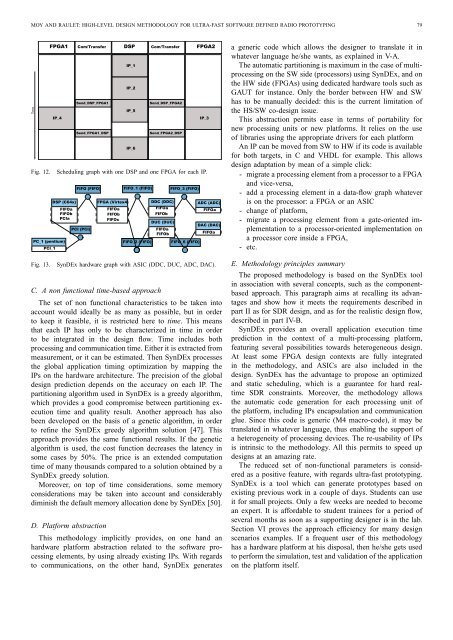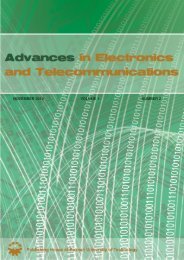channel - Advances in Electronics and Telecommunications
channel - Advances in Electronics and Telecommunications
channel - Advances in Electronics and Telecommunications
Create successful ePaper yourself
Turn your PDF publications into a flip-book with our unique Google optimized e-Paper software.
MOY AND RAULET: HIGH-LEVEL DESIGN METHODOLOGY FOR ULTRA-FAST SOFTWARE DEFINED RADIO PROTOTYPING 79<br />
Time<br />
FPGA1 Com/Transfer DSP Com/Transfer FPGA2<br />
Send_DSP_FPGA1<br />
IP_4 IP_3<br />
Send_FPGA1_DSP<br />
IP_1<br />
IP_2<br />
IP_5<br />
IP_6<br />
Send_DSP_FPGA2<br />
Send_FPGA2_DSP<br />
Fig. 12. Schedul<strong>in</strong>g graph with one DSP <strong>and</strong> one FPGA for each IP.<br />
PC_1 (pentium)<br />
PCI_1<br />
DSP (C64x)<br />
FIFOa<br />
FIFOb<br />
PCIa<br />
FIFO (FIFO)<br />
PCI (PCI)<br />
FPGA (Virtex4)<br />
FIFOa<br />
FIFOb<br />
FIFOc<br />
FIFO_1 (FIFO)<br />
FIFO_2 FIFO_5 FIFO_4 (FIFO (FIFO) )<br />
DDC (DDC)<br />
FIFOa<br />
FIFOb<br />
DUC (DUC)<br />
FIFOa<br />
FIFOb<br />
FIFO_3 (FIFO)<br />
FIFO_6 (FIFO)<br />
ADC (ADC)<br />
FIFOa<br />
DAC (DAC)<br />
FIFOa<br />
Fig. 13. SynDEx hardware graph with ASIC (DDC, DUC, ADC, DAC).<br />
C. A non functional time-based approach<br />
The set of non functional characteristics to be taken <strong>in</strong>to<br />
account would ideally be as many as possible, but <strong>in</strong> order<br />
to keep it feasible, it is restricted here to time. This means<br />
that each IP has only to be characterized <strong>in</strong> time <strong>in</strong> order<br />
to be <strong>in</strong>tegrated <strong>in</strong> the design flow. Time <strong>in</strong>cludes both<br />
process<strong>in</strong>g <strong>and</strong> communication time. Either it is extracted from<br />
measurement, or it can be estimated. Then SynDEx processes<br />
the global application tim<strong>in</strong>g optimization by mapp<strong>in</strong>g the<br />
IPs on the hardware architecture. The precision of the global<br />
design prediction depends on the accuracy on each IP. The<br />
partition<strong>in</strong>g algorithm used <strong>in</strong> SynDEx is a greedy algorithm,<br />
which provides a good compromise between partition<strong>in</strong>g execution<br />
time <strong>and</strong> quality result. Another approach has also<br />
been developed on the basis of a genetic algorithm, <strong>in</strong> order<br />
to ref<strong>in</strong>e the SynDEx greedy algorithm solution [47]. This<br />
approach provides the same functional results. If the genetic<br />
algorithm is used, the cost function decreases the latency <strong>in</strong><br />
some cases by 50%. The price is an extended computation<br />
time of many thous<strong>and</strong>s compared to a solution obta<strong>in</strong>ed by a<br />
SynDEx greedy solution.<br />
Moreover, on top of time considerations, some memory<br />
considerations may be taken <strong>in</strong>to account <strong>and</strong> considerably<br />
dim<strong>in</strong>ish the default memory allocation done by SynDEx [50].<br />
D. Platform abstraction<br />
This methodology implicitly provides, on one h<strong>and</strong> an<br />
hardware platform abstraction related to the software process<strong>in</strong>g<br />
elements, by us<strong>in</strong>g already exist<strong>in</strong>g IPs. With regards<br />
to communications, on the other h<strong>and</strong>, SynDEx generates<br />
a generic code which allows the designer to translate it <strong>in</strong><br />
whatever language he/she wants, as expla<strong>in</strong>ed <strong>in</strong> V-A.<br />
The automatic partition<strong>in</strong>g is maximum <strong>in</strong> the case of multiprocess<strong>in</strong>g<br />
on the SW side (processors) us<strong>in</strong>g SynDEx, <strong>and</strong> on<br />
the HW side (FPGAs) us<strong>in</strong>g dedicated hardware tools such as<br />
GAUT for <strong>in</strong>stance. Only the border between HW <strong>and</strong> SW<br />
has to be manually decided: this is the current limitation of<br />
the HS/SW co-design issue.<br />
This abstraction permits ease <strong>in</strong> terms of portability for<br />
new process<strong>in</strong>g units or new platforms. It relies on the use<br />
of libraries us<strong>in</strong>g the appropriate drivers for each platform<br />
An IP can be moved from SW to HW if its code is available<br />
for both targets, <strong>in</strong> C <strong>and</strong> VHDL for example. This allows<br />
design adaptation by mean of a simple click:<br />
- migrate a process<strong>in</strong>g element from a processor to a FPGA<br />
<strong>and</strong> vice-versa,<br />
- add a process<strong>in</strong>g element <strong>in</strong> a data-flow graph whatever<br />
is on the processor: a FPGA or an ASIC<br />
- change of platform,<br />
- migrate a process<strong>in</strong>g element from a gate-oriented implementation<br />
to a processor-oriented implementation on<br />
a processor core <strong>in</strong>side a FPGA,<br />
- etc.<br />
E. Methodology pr<strong>in</strong>ciples summary<br />
The proposed methodology is based on the SynDEx tool<br />
<strong>in</strong> association with several concepts, such as the componentbased<br />
approach. This paragraph aims at recall<strong>in</strong>g its advantages<br />
<strong>and</strong> show how it meets the requirements described <strong>in</strong><br />
part II as for SDR design, <strong>and</strong> as for the realistic design flow,<br />
described <strong>in</strong> part IV-B.<br />
SynDEx provides an overall application execution time<br />
prediction <strong>in</strong> the context of a multi-process<strong>in</strong>g platform,<br />
featur<strong>in</strong>g several possibilities towards heterogeneous design.<br />
At least some FPGA design contexts are fully <strong>in</strong>tegrated<br />
<strong>in</strong> the methodology, <strong>and</strong> ASICs are also <strong>in</strong>cluded <strong>in</strong> the<br />
design. SynDEx has the advantage to propose an optimized<br />
<strong>and</strong> static schedul<strong>in</strong>g, which is a guarantee for hard realtime<br />
SDR constra<strong>in</strong>ts. Moreover, the methodology allows<br />
the automatic code generation for each process<strong>in</strong>g unit of<br />
the platform, <strong>in</strong>clud<strong>in</strong>g IPs encapsulation <strong>and</strong> communication<br />
glue. S<strong>in</strong>ce this code is generic (M4 macro-code), it may be<br />
translated <strong>in</strong> whatever language, thus enabl<strong>in</strong>g the support of<br />
a heterogeneity of process<strong>in</strong>g devices. The re-usability of IPs<br />
is <strong>in</strong>tr<strong>in</strong>sic to the methodology. All this permits to speed up<br />
designs at an amaz<strong>in</strong>g rate.<br />
The reduced set of non-functional parameters is considered<br />
as a positive feature, with regards ultra-fast prototyp<strong>in</strong>g.<br />
SynDEx is a tool which can generate prototypes based on<br />
exist<strong>in</strong>g previous work <strong>in</strong> a couple of days. Students can use<br />
it for small projects. Only a few weeks are needed to become<br />
an expert. It is affordable to student tra<strong>in</strong>ees for a period of<br />
several months as soon as a support<strong>in</strong>g designer is <strong>in</strong> the lab.<br />
Section VI proves the approach efficiency for many design<br />
scenarios examples. If a frequent user of this methodology<br />
has a hardware platform at his disposal, then he/she gets used<br />
to perform the simulation, test <strong>and</strong> validation of the application<br />
on the platform itself.







